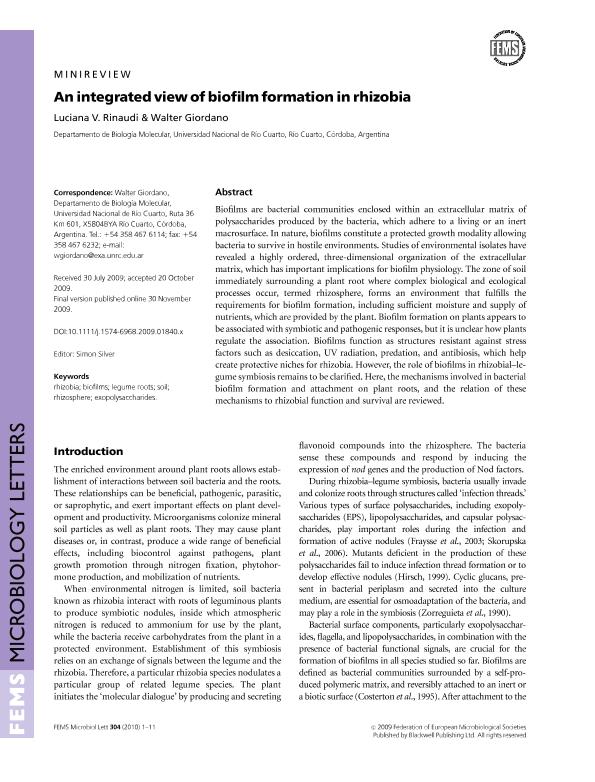Mostrar el registro sencillo del ítem
dc.contributor.author
Rinaudi, Luciana Veronica

dc.contributor.author
Giordano, Walter Fabian

dc.date.available
2020-07-21T15:15:40Z
dc.date.issued
2010-02
dc.identifier.citation
Rinaudi, Luciana Veronica; Giordano, Walter Fabian; An integrated view of biofilm formation in Rhizobia; Wiley Blackwell Publishing, Inc; FEMS Microbiology Letters; 304; 1; 2-2010; 1-11
dc.identifier.issn
0378-1097
dc.identifier.uri
http://hdl.handle.net/11336/109724
dc.description.abstract
Biofilms are bacterial communities enclosed within an extracellular matrix of polysaccharides produced by the bacteria, which adhere to a living or an inert macrosurface. In nature, biofilms constitute a protected growth modality allowing bacteria to survive in hostile environments. Studies of environmental isolates have revealed a highly ordered, three-dimensional organization of the extracellular matrix, which has important implications for biofilm physiology. The zone of soil immediately surrounding a plant root where complex biological and ecological processes occur, termed rhizosphere, forms an environment that fulfills the requirements for biofilm formation, including sufficient moisture and supply of nutrients, which are provided by the plant. Biofilm formation on plants appears to be associated with symbiotic and pathogenic responses, but it is unclear how plants regulate the association. Biofilms function as structures resistant against stress factors such as desiccation, UV radiation, predation, and antibiosis, which help create protective niches for rhizobia. However, the role of biofilms in rhizobial–legume symbiosis remains to be clarified. Here, the mechanisms involved in bacterial biofilm formation and attachment on plant roots, and the relation of these mechanisms to rhizobial function and survival are reviewed.
dc.format
application/pdf
dc.language.iso
eng
dc.publisher
Wiley Blackwell Publishing, Inc

dc.rights
info:eu-repo/semantics/openAccess
dc.rights.uri
https://creativecommons.org/licenses/by-nc-sa/2.5/ar/
dc.subject
BIOFILM FORMATION
dc.subject
RHIZOBIA
dc.subject.classification
Biología Celular, Microbiología

dc.subject.classification
Ciencias Biológicas

dc.subject.classification
CIENCIAS NATURALES Y EXACTAS

dc.title
An integrated view of biofilm formation in Rhizobia
dc.type
info:eu-repo/semantics/article
dc.type
info:ar-repo/semantics/artículo
dc.type
info:eu-repo/semantics/publishedVersion
dc.date.updated
2020-07-20T20:23:46Z
dc.identifier.eissn
1574-6968
dc.journal.volume
304
dc.journal.number
1
dc.journal.pagination
1-11
dc.journal.pais
Reino Unido

dc.journal.ciudad
Londres
dc.description.fil
Fil: Rinaudi, Luciana Veronica. Universidad Nacional de Río Cuarto. Facultad de Ciencias Exactas Fisicoquímicas y Naturales. Departamento de Biología Molecular; Argentina
dc.description.fil
Fil: Giordano, Walter Fabian. Universidad Nacional de Rio Cuarto. Facultad de Cs.exactas Fisicoquimicas y Naturales. Instituto de Biotecnologia Ambiental y Salud. - Consejo Nacional de Investigaciones Cientificas y Tecnicas. Centro Cientifico Tecnologico Conicet - Cordoba. Instituto de Biotecnologia Ambiental y Salud.; Argentina
dc.journal.title
FEMS Microbiology Letters

dc.relation.alternativeid
info:eu-repo/semantics/altIdentifier/url/https://pubmed.ncbi.nlm.nih.gov/19930462/
dc.relation.alternativeid
info:eu-repo/semantics/altIdentifier/doi/http://dx.doi.org/10.1111/j.1574-6968.2009.01840.x
dc.relation.alternativeid
info:eu-repo/semantics/altIdentifier/pmid/19930462
Archivos asociados
